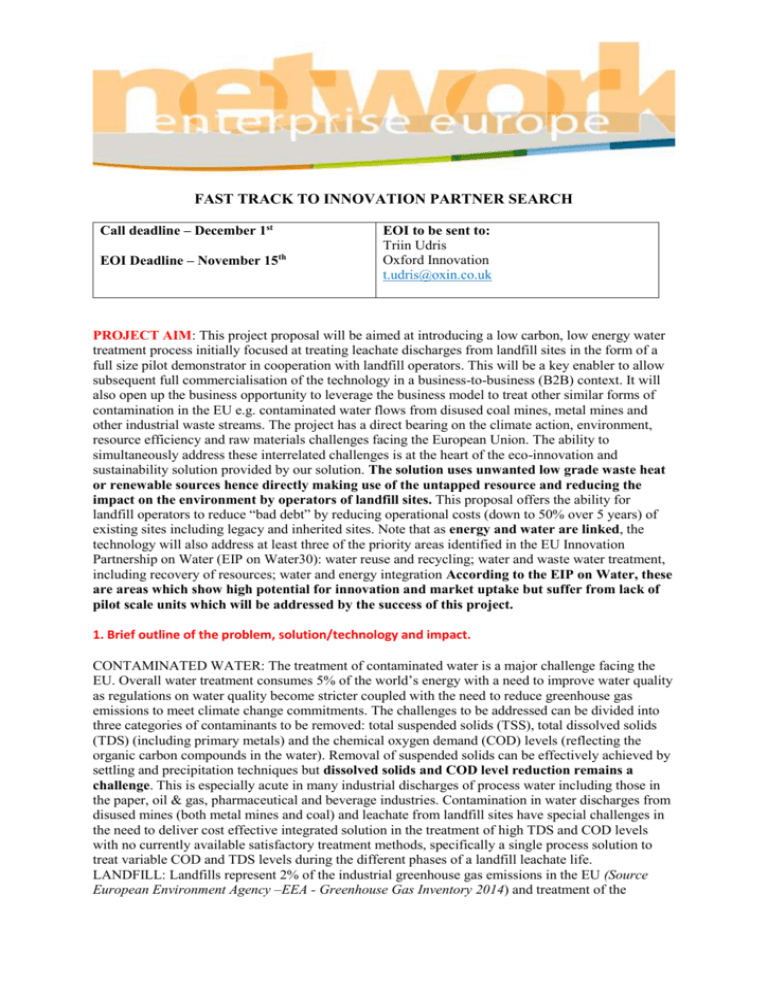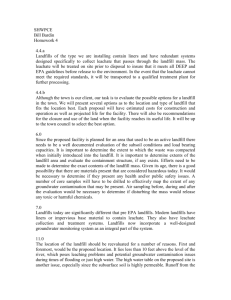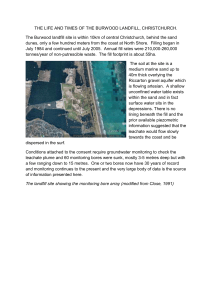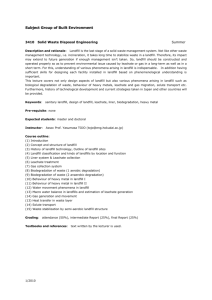FAST TRACK TO INNOVATION PARTNER SEARCH Call deadline
advertisement

FAST TRACK TO INNOVATION PARTNER SEARCH Call deadline – December 1st EOI Deadline – November 15th EOI to be sent to: Triin Udris Oxford Innovation t.udris@oxin.co.uk PROJECT AIM: This project proposal will be aimed at introducing a low carbon, low energy water treatment process initially focused at treating leachate discharges from landfill sites in the form of a full size pilot demonstrator in cooperation with landfill operators. This will be a key enabler to allow subsequent full commercialisation of the technology in a business-to-business (B2B) context. It will also open up the business opportunity to leverage the business model to treat other similar forms of contamination in the EU e.g. contaminated water flows from disused coal mines, metal mines and other industrial waste streams. The project has a direct bearing on the climate action, environment, resource efficiency and raw materials challenges facing the European Union. The ability to simultaneously address these interrelated challenges is at the heart of the eco-innovation and sustainability solution provided by our solution. The solution uses unwanted low grade waste heat or renewable sources hence directly making use of the untapped resource and reducing the impact on the environment by operators of landfill sites. This proposal offers the ability for landfill operators to reduce “bad debt” by reducing operational costs (down to 50% over 5 years) of existing sites including legacy and inherited sites. Note that as energy and water are linked, the technology will also address at least three of the priority areas identified in the EU Innovation Partnership on Water (EIP on Water30): water reuse and recycling; water and waste water treatment, including recovery of resources; water and energy integration According to the EIP on Water, these are areas which show high potential for innovation and market uptake but suffer from lack of pilot scale units which will be addressed by the success of this project. 1. Brief outline of the problem, solution/technology and impact. CONTAMINATED WATER: The treatment of contaminated water is a major challenge facing the EU. Overall water treatment consumes 5% of the world’s energy with a need to improve water quality as regulations on water quality become stricter coupled with the need to reduce greenhouse gas emissions to meet climate change commitments. The challenges to be addressed can be divided into three categories of contaminants to be removed: total suspended solids (TSS), total dissolved solids (TDS) (including primary metals) and the chemical oxygen demand (COD) levels (reflecting the organic carbon compounds in the water). Removal of suspended solids can be effectively achieved by settling and precipitation techniques but dissolved solids and COD level reduction remains a challenge. This is especially acute in many industrial discharges of process water including those in the paper, oil & gas, pharmaceutical and beverage industries. Contamination in water discharges from disused mines (both metal mines and coal) and leachate from landfill sites have special challenges in the need to deliver cost effective integrated solution in the treatment of high TDS and COD levels with no currently available satisfactory treatment methods, specifically a single process solution to treat variable COD and TDS levels during the different phases of a landfill leachate life. LANDFILL: Landfills represent 2% of the industrial greenhouse gas emissions in the EU (Source European Environment Agency –EEA - Greenhouse Gas Inventory 2014) and treatment of the leachate is the largest cost of operation of these sites (estimated at 60% of OPEX budget of a landfill operator such as Suez Environnement). Methane emitted by the landfill is a highly virulent greenhouse gas (up to 25 times the intensity of CO2). Methane emissions from (biodegradable waste in) landfill account for 40% of all EU methane emissions (Methane is 23 times as damaging a greenhouse gas as carbon dioxide). Its capture and elimination during the landfill process is a key part of achieving reduction targets (20% in 2020, 30% in 2030) in greenhouse gas (GHG) emissions by EU countries to comply below the 2° global warming target (Source United Nations Framework Convention On Climate Change and Kyoto Protocol) Treatment of leachate by reusing otherwise discharged low grade waste heat from the methane-gas fuelled generators at landfill sites is one of the key features of the technology and is aligned with the move towards “waste to resource” trends observed in the EU and internationally, and will contribute to reduce carbon emissions. Extent of the problem: The current legacy systems in the EU involve removal to an offsite hazardous waste disposal facility, where the leachate is incinerated at high temperature and the resulting ash returned back to a landfill site. This creates unnecessarily transport and fuel costs (> 50% of transport and disposal OPEX costs for an operator), road congestion, risk of environment spills and CO2 release. There are other variants involving membrane separation or chemical/biological separation but they suffer from similar cost and environmental issues. The leachate aeration process involves significant CO2 emissions arising from: the agitation of the leachate – to extract and discharge the dissolved methane prior to disposal, transport costs and emissions (typically in trucking the leachate away), and the ultimate incineration process or other treatment process. Variations of the process involve the use of Reverse Osmosis membrane technology to separate clean water from the contaminated concentrate but this is of limited applicability due to the chemical make-up of the leachate and the high energy costs of operating a reverse osmosis system. The current legacy disposal/treatment process costs between €7.50 and €20 per cubic metre of leachate to the landfill operator (source UK Environment Agency). The estimated annual cost of this leachate disposal across the EU exceeds € 3,500 million. Although there are a declining number of “in use” landfill sites in the EU (following the Council Directive 1999/31/EC of 26 April 1999 to reduce landfill disposal of waste) the closed sites continue to generate leachate for up to 50 years after ceasing to accept new waste thus leachate management is an ongoing challenge for all the EU countries. Across the EU, there are in excess of 50,000 sites generating leachate in excess of 2.5 million m3/d. Based on the targeted performance a landfill operator would achieve a payback on their investment using the technology between 2.8 to 3.8 years. 2. Main activities to be undertaken. There are currently no satisfactory systems for effective reduction of TDS and COD levels of leachate water at landfill sites. The main objective of this project is to demonstrate the application of the proven SolaQuaGen Water Machine (SQGWM) technology for in line leachate treatment via the implementation of a pilot at an end user site, preferably in the UK for reasons of practicality, cost and ease of management. The pilot shall be a scaled up and refined version of the SQGWM technology prototype unit which was partially funded from concept to prototype by three successive grants from Innovate UK and the UK Department of Energy and Climate Change (DECC). The overall objective of the project is to build and install a demonstrator SQGWM at the site of a landfill operator and bringing it to full operation there. This objective will allow SQG to validate the design in a full operating context and demonstrate unique selling points such as >95% reduction in COD levels for young, intermediate and old leachates, < 10 mg/l of TDS for product water and zero CO2 emissions from waste heat utilisation. 3. Type of partners do you need and their roles. a. Partners who manage waste water and/or landfill sites – for example pharmaceutical plants, Oil & Gas refineries, metal/coal mines, landfill operators with waste water treatment facilities b. Newer EU member states are more likely to have plants/landfill sites that could really benefit from this and will have suitable sites. But others are not excluded. Role of the partners: a. Provide a site for testing b. Provide waste heat sources for us to use as source of thermal energy






